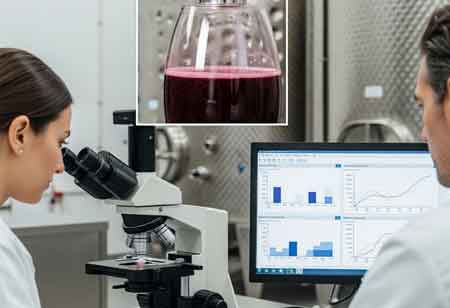THANK YOU FOR SUBSCRIBING
Be first to read the latest tech news, Industry Leader's Insights, and CIO interviews of medium and large enterprises exclusively from Food and Beverage Tech Review
Advances in Pathogen Detection Technologies for Wine Producers: Ensuring Food Safety in Fermentation-Based Industries
The wine industry is leveraging scientific advancements in microbial control and rapid detection technologies to enhance food safety, quality, and profitability while minimizing spoilage and contamination risks.

By
Food and Beverages Tech Review | Friday, June 27, 2025
Stay ahead of the industry with exclusive feature stories on the top companies, expert insights and the latest news delivered straight to your inbox. Subscribe today.
Fremont, CA: The art of winemaking, steeped in tradition, is undergoing a revolution driven by scientific advancements, particularly in the realm of microbial control. While the fermentation process itself is crucial for wine production, it also presents unique challenges for food safety. Undesirable microorganisms, also known as "spoilage organisms," can compromise wine quality, flavor, and shelf life, resulting in significant economic losses for producers. Beyond spoilage, the broader fermentation industry, including wine, must also remain vigilant against potential human pathogens. Fortunately, cutting-edge pathogen detection technologies are empowering wine producers to ensure both product quality and consumer safety with unprecedented precision and speed.
A New Era of Rapid and Accurate Detection
The wine industry is embracing rapid detection methods that are not only effective but also efficient, enabling the prevention of potential issues early on. Molecular-based techniques, such as PCR and qPCR, provide a sensitive and accurate detection of pathogens, enhancing the productivity of professionals. PCR-based kits monitor spoilage organisms, while RT-PCR targets metabolically active cells, further increasing efficiency. Loop-Mediated Isothermal Amplification (LAMP) is well-suited for on-site testing in less-equipped laboratories, offering a quick and effective solution. Next-generation sequencing (NGS) and metagenomic analysis are transforming the understanding of microbial ecosystems in wine, providing professionals with deeper insights and increasing their effectiveness. Biosensors and immunological assays offer practical solutions for rapid, on-site screening, including lateral flow immunoassays (LFAs) and ATP bioluminescence assays. These technologies are enabling a strategic shift from reactive problem-solving to proactive prevention, making professionals more effective in their roles.
Benefits for Wine Producers
Technological advancements in microbial detection and control offer a range of significant benefits for wine producers. Enhanced food safety is a primary advantage, as the proactive identification of spoilage organisms and potential human pathogens significantly reduces the risk of contaminated products reaching consumers. This not only protects public health but also helps preserve brand reputation. The early detection of microbial issues enables timely interventions, ensuring product quality and consistency by preventing defects such as off-flavors and haze. These capabilities also contribute to reduced economic losses, as minimizing spoilage and avoiding costly product recalls directly enhances profitability. The availability of real-time data from rapid detection methods enables producers to optimize production processes, fine-tune fermentation conditions, improve filtration, and make informed decisions regarding storage and bottling.
Pathogen detection in fermentation-based industries, such as winemaking, is rapidly evolving, with advanced technologies increasingly integrated into routine operations. As sequencing costs continue to drop and miniaturization advances, portable detection devices become more prevalent; even smaller wineries will have access to sophisticated microbial monitoring tools.
The synergistic application of these technologies – using rapid screening methods for initial checks, molecular techniques for targeted confirmation, and NGS for in-depth microbial profiling – will define the future of food safety and quality control in the wine industry. By embracing these innovations, wine producers can continue to craft wines while upholding the highest standards of food safety, protecting both their cherished product and the health of their consumers.
I agree We use cookies on this website to enhance your user experience. By clicking any link on this page you are giving your consent for us to set cookies. More info







